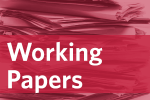
In this study, we aim to quantify the impact of information provision on jobseeker attention and applications. We explore how firms may improve job ad effectiveness through obtaining and maintaining a “company page” on an online job search platform. We study the implications of these firm actions on job ad performance and for jobseekers’ search. We also explore if information provision yields heterogeneous effects across firms of different sizes.…Read More




